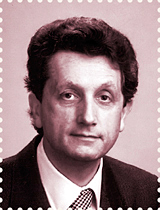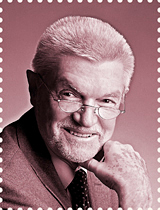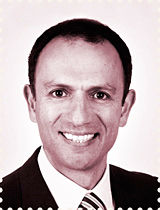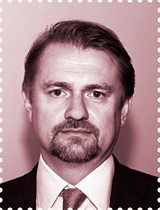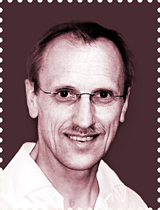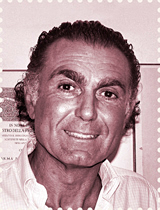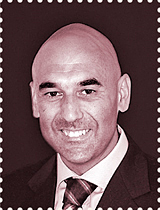KEYNOTE LECTURES
Invisalign – a new challenge in orthodontics: A comprehensive overview after 13 years experience
Thursday, September 26, 2013
RAINER REGINALD MIETHKE
Professor Miethke studied at the Freie Universität in Berlin where he received his certificate in orthodontics (Fachzahnarzt für Kieferorthopädie) in 1973 and his Ph.D. in 1978.
From 1978 to 79 Professor Miethke got fixed appliance training at the Orthodontic Department of the Louisiana State University in New Orleans. From 1983 to1994 he was the Head of the Department of Orthodontics and Pedodontics at the Freie Universität in Berlin and held a guest-professorship at the Orthodontics Department of the Royal Dental College in Århus (Denmark, 1992–1993). From 1992 to 2009 he was the Head of the Department of Orthodontics at Humboldt University in Berlin.
In 2009, Professor Miethke was appointed Head of the Department of Dentistry, Hamad Medical Corporation in Doha, Qatar – a post which he holds until the present day. In 2002, Professor Miethke acted as Vice-Dean of the Charité Centre of Oral Medicine at Humboldt University.
Professor Miethke is a former Board Member and President of the European Orthodontic Society, former Editor-in-Chief of Praktische Kieferorthopädie“ (later „Kieferorthopädie“), former Editor-in-Chief of the World Journal of Orthodontics and member of the Advisory Board of the College of the North Atlantic – Qatar in Doha.
He was the President of the Annual Conference of the German Society of Orthodontics held in Berlin in 1987 and 1992, and is the former President of the German Association of Aligner Orthodontics and President of the 1st and 2nd Congress of the German Association of Aligner Orthodontics (Cologne, 2010 and 2012).
Professor Miethke is an Honorary Member of the Lebanese Orthodontic Society and the Thai Orthodontic Society, Honourable Consultant of the Macao Association of Orthodontics, Honorary Member of the Association of Orthodontics of Berlin and Brandenburg and scientific expert for the Deutsche Forschungsgemeinschaft (Germany's largest research funding organisation). Professor Miethke is a referee reporting for many scientific journals.
Treatment with clear plastic splints became very popular in past years which can be attributed to a large scale to the introduction of the Invisalign system. The so-called invisible braces have their merits under certain conditions. In these circumstances they are superior to any other treatment modality. Also it cannot be overlooked that more and more patients request Invisalign treatment. Though their preference should be taken very seriously orthodontists have to know well about the limitations of treatment with aligners, too. This lecture will demonstrate what can be accomplished with the Invisalign system, when it seems to be preferable to other treatment approaches, and how with the use of auxiliaries existing limits of the Invisalign system can be expanded.
Because of the lecturer's familiarity with many hundreds of Invisalign therapies all important aspects will be underscored with numerous patient examples.
Treatment strategies to correct Class II using the Incognito™ Appliance System in combination with Herbst® Appliances on both adults and teenagers
Friday, September 27, 2013
ESFANDIAR MODJAHEDPOUR
Dr. Modjahedpour Modjahedpour was born on 21. 09. 1969 Düsseldorf / Germany.
In 1989–1994 Studies of Dentistry Semmelweis University Budapest. In 1991 Intern at Lenox Hill Hospital New York / USA, in 1994 Doctoral Dissertation.
Since 1997 – Specialist of Orthodontics and dentofacialorthopedics, since 2001 – Privat Orthodontic Practice in Krefeld / Germany.
Since 2008 Master of Science in Lingual Orthodontics Medical University Hanover, Germany.
Since 2008 Accredited and active Member of European Society in Lingual Orthodontics (ESLO) and Accredited and active Member of German Society in Lingual Orthotontics (DGLO).
2010 President of the German Society in Lingual Orthodontics (DGLO) Congress in Düsseldorf / Germany.
The purpose of the study is to propose a straightforward treatment approach to correct Class II cases with an individual appliance in combination with Herbst Appliances or Forsus Class II Correctors. Clinical aspects in terms of treatment and appliance design will be shown and discussed.
Lingual treatment with the Incognito Appliance System and Herbst Appliances or Forsus Class II Correctors provides reliable treatment results in the correction of Class II. Treatment objectives could be achieved with both appliances. Managing Class II treatment in lingual orthodontics is a frequent and sometimes challenging treatment objective. Herbst Appliances or Forsus Class II Correctors, which are both well known in labial treatments, can provide a secure treatment method to correct Class II both for teenagers and adults. Customized appliances like the Incognito Appliance System allow a design of the brackets and bands in order to control any side effects. Establishing these treatment strategies will open new possibilities to implement lingual orthodontics successfully in our practices.
“Surgery First” in combined orthodontic and surgical treatment of facial skeletal effects
Friday, September 27, 2013
RENÉ FOLTÁN
Assoc. Prof. René Foltán acquired his training at Medical Faculty of Charles University in Hradec Králové, where he gained his degree in Dentistry and then also in General Medicine.
After completing his studies he connected his carrier with the 1st Medical Faculty of Charles University in Prague where he became an assistant professor in 1996 at the department of Oral and Maxillofacial Surgery. Key part of his training as a maxillofacial surgeon is associated with many clerkships abroad, especially in University Hospital Zürich with Prof. H. Sailer and Royal Surrey County Hospital, Guildford, United Kingdom with Mr. P.A. Johnson and Prof. P. Haers, where he worked as locum registrar and later as honorary senior house officer.
In 2006 he obtained Fellowship of the European Board of Oro-Maxillofacial Surgery (FEBOMFS). He defended PhD thesis on the topic „Genioglossus advancement in therapy of obstrucive sleep apnea syndrome (OSAS)“ in 2007.
Dr. Foltán became an Associate Proffessor in 2011. He is particularly interested in orthognathic surgery for the patients with severe skeletal malocclusions and OSAS. He has lectured extensively on many czech and international scientific congresses and is an author of many scientific papers. He is a scientific secretary of Czech Society for Maxillofacial surgery, member and councilor of Czech Republic at the European Association for Cranio-Maxillofacial Surgery and member of many other scientific societies.
Ever since Brachvogel's first mention of the concept of orthognathic surgery preceding orthodontic treatment in 1991, new scientific findings and studies have allowed the inclusion of this concept among standard therapeutic procedures in combined orthodontic-surgical therapy. The main benefits are the significantly shorter duration of therapy and early aesthetic effect for the patient.
In our contribution we shall focus on the basic physiological mechanisms at play in the acceleration of tooth movement, especially the effect of the surgical procedure on blood perfusion of the bones and the role of the soft tissues of the stomatognathic system affecting the biological space needed for the tooth to function. We shall also point out the stumbling blocks in the clinical preparation of the patient for surgery. The planning of therapy is a difficult task even for experienced orthodontists and surgeons. We shall focus on the most common errors and present the results of a group of more than 20 patients who have undergone the therapy. We shall outline the future trends of development in orthognathic surgery, especially in combination with other modern procedures, especially Speedy orthodontics.
New concept of gaining space in orthodontics
Friday, September 27, 2013
HEINZ WINSAUER
Dr. Heinz Winsauer – Doctors degree in general medicine and dental medicine at the University of Innsbruck. (1974 – 1986). Specialisation in orthodontics at the Dental University of Innsbruck (Prof. M. Richter) 1987 – 1990. In private office since 1990. First Austrian orthodontist in private office with European Board examination in 1998. Member of the European Board of orthodontists, diplomat of the Austrian Board of orthodontists.
Nine international orthodontic patents. Scientific research at the Graz Dental University for moment/force quantification in rapid maxillary expansion (RME). Numerous articles and presentations.
Scientific focuses: Rapid maxillary expansion, Torque of teeth, intermaxillary force deliverance (FlexDeveloper), compliance free molar distalisation (TopJet), MI based maxillary expansion, early treatment of Angle Cl. III.
The routine use of orthodontic mini-implants (OMI) in modern orthodontics has created new compliance free, highly effective treatment techniques reaching goals that could not be dreamed of before. The anterior palate is a safe and reliable site to place OMIs securely in a short in-office procedure done by the orthodontist him-/herself. 1 uni- or 2 bilateral OMIs can be used for distalization of upper buccal teeth with invisible appliances at a rate of 0,8 mm per month. Thereafter the same 2 OMIs are again used to support a mini-implant and molar borne Hybrid-Hyrax expander, which during expansion will keep the molars in their distalized position. Another option is the pure bone borne MICRO4/6 Hyrax expander supported by 4 to 6 OMIs alone. Measurements in the university of Catalonia, Barcelona, proofed, that up to 400 N can be loaded per OMI. The placement and the removal of these expanders is done in a few minutes which guarantees simple clinical use. Due to the secure bony anchorage the age of patients for maxillary expansion has risen up to 25 years and more and appears to be a save procedure without the need of surgical assisted rapid palatal expansion (SARPE). Also the mandible can easily be expanded by median distraction osteogenesis, since the invention of a minimal invasive procedure that makes osteotomy possible within 15 minutes almost without scars. The distractor is fixed dentally, thus not needing placement and removal of bone screws.
These new compliance free techniques offer the possibility to easily gain space in the upper and lower jaw between 4 to14 millimeters and therefore reduce the need of tooth extractions significantly.
Contemporary Orthodontic treatment of adult patients: How to get periodontally healthy tissues and a reduced treatment, with a mini invasive approach
Saturday, September 28, 2013
GIULIANO MAINO
Dr. Giuliano Maino graduate in Medicine and Dentistry; Post Graduate in Orthodontics at Cagliari University. Post Graduated Clinical Training in Orthodontics at Boston University – Director Prof. Anthony A. Gianelly. Visiting Professor of Orthodontics at Ferrara University, Parma University and Insubria University. Private Practice in Orthodontics in Vicenza.
Lecturer in Orthodontics in Italy, Europe and USA; Author and Co-author of 3 books and more than 90 scientific papers. Active member of A.S.E. (the Angle Society of Europe). Active member of S.I.D.O. (Italian Society of Orthodontics). Active member of S.I.d.P. (Italian Society of Periodontology). International Member of A.A.O. (American Association of Orthodontics). Member of E.O.S. (European Orthodontic Society).
Certified of Excellence in Orthodontics I.B.O. (Italian Board of Orthodontics) and E.B.O. (European Board of Orthodontics). Past President of S.I.Te.Bi. (Italian Society of Bidimensional Technique). Past President of A.S.I.O. (Italian Association of Specialists in Orthodontics). Past President of A.I.D.Or. (Italian Academy of Orthodontists). Past President of W.I.O.C. (World Implant Orthodontic Conference).
STEFANO PARMA BENFENATI
Dr. Stefano Parma Benfenati received his medical degree at Ferrara University (Italy) in 1978 and specialized in Dentistry at Genova University in 1981. He obtained a “Master of Science in Periodontology” at Boston University in 1984. Since 1987 he has been an active member of the Italian Society of Periodontology.
Dr. Parma Benfenati has lectured widely, co-authored many articles and books. He was formerly a Professor for the Periodontology Course at Ferrara University from 1986 to 2000. He is a teaching Professor at Padova University for the Master Program in Implantology, focusing on GBR topics. He is teaching Professor at Torino University for the Master Program in Periodontology focusing on Muco-gingival Surgery.
He maintains a private practice in Periodontology and Implantology in Ferrara (Italy).
The demands of adult orthodontic patients are made in particular by aesthetics, minimal collaboration and a reduced treatment length. Bone surgery is one of the proposed methods to accelerate tooth movement and at the same time preserving the periodontal support.
In a patient oriented context, in order to minimize the request for patient cooperation new orthodontic mechanics have been developed that, using TADs, can provide results once unthinkable with minimum or none cooperation. Furthermore, to make the surgical approach easier and less traumatic new minimaxy invasive techniques have been developed in order to make the combined orthodontic and periodontal approach easily applied. By using this type of approach optimum results with periodontal health, reduced treatment time and lack of cooperation can be obtained.
This presentation will illustrate with a “step by step” approach the orthodontic-surgical techniques that can be used to treat different malocclusions, their evolution up to miniinvasive approach and the combined use of skeletal anchorage. Finally some results on researches performed in animals and human using the previous combined techniques will be presented.
Orthodontic Microsurgery
Saturday, September 28, 2013
ANDREA PODESTÀ
Dr. Andrea Podestà Dr. Andrea Podestà graduated In 1989 from the University of Genoa with full honours in medicine and went on to become a Doctor in Dental Surgery. He has practiced Orthodontics since 1990.
Dr. Podestà's research keeps him constantly up-to-date on international developments in dentistry and he is a regular lecturer and speaker for several major scientific organisations and societies, especially in Italy, France, the USA and Canada, including the American Association of Orthodontists and the World Federation of Orthodontists.
He has collaborated as a key opinion leader for 3M Unitek and Ormco in product development and for conducting training programs.
Dr. Podestà is the co-inventor, together with Prof. Tomaso Vercellotti, of the Orthodontic Microsurgery Technique and he continues to hold international courses on its use and application.
In traditional orthodontic treatment dental movement takes place through bone resorption following pressure on the periodontal ligament. This technique is considered the gold standard for treating young patients.
Adult patients, however, are characterized by higher bone crest mineralization thus making traditional orthodontic movement the cause of root reabsorption in 90% of cases. Traditional methods also involve considerable length of treatment time.
Orthodontic Microsurgery is a new surgically guided technique characterized by tooth and cortical displacement in the direction of movement and rapid ligament distraction on the opposite root surface.
Biological rationale and clinical cases will be presented.
